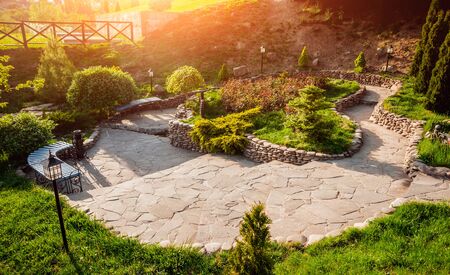Assessing Your Current Landscape
If you want to transform your yard into a water-saving xeriscaped paradise, the first step is to understand what you’re working with. Assessing your current landscape will help you make smart choices and maximize your investment. Start by evaluating your yard’s water usage—review your past water bills to see how much you’re spending on irrigation and identify high-consumption areas. Next, dig a little deeper (literally) into your soil quality. Take a handful of soil and check its texture: is it sandy, clay-heavy, or loamy? You can also get a basic soil test kit from a local home improvement store to determine pH and nutrient content. This matters because healthy soil retains moisture better, reducing your need for supplemental watering.
Sun exposure is another key factor in xeriscaping success. Spend a day mapping out which areas of your yard get full sun, partial shade, or deep shade throughout the day. Use this info to plan where drought-tolerant plants will thrive versus where hardscape elements like gravel or mulch might work best. Finally, take inventory of existing plants—some may already be drought-resistant or could be relocated to suit your new design. By thoroughly assessing these four aspects—water usage, soil quality, sun exposure, and plant inventory—you’ll lay the groundwork for an efficient and beautiful xeriscape that boosts curb appeal and saves money long-term.
2. Creating a Xeriscape Design Plan
Before you start ripping out your existing turf or planting drought-resistant beauties, it’s critical to develop a smart xeriscape design plan that boosts curb appeal and maximizes your investment return. Here’s how to set yourself up for success:
Map Out Your Vision
First, walk your property and take note of sun exposure, slopes, drainage, and existing hardscape features. Sketch a basic map or use a landscape design app to plot out your space. Identify what works (like mature trees) and what needs replacing or removing.
Pro Tip: Involve the Family
Get input from everyone who uses the yard—kids might want play zones, while adults may value entertaining spaces or privacy screens.
Choose the Right Layout
Think about functionality and flow. Group plants with similar water needs together (a core xeriscaping principle), and place hardscape elements like patios or paths where they’ll get the most use. Consider these layout options based on your goals:
| Goal | Layout Feature | ROI Impact |
|---|---|---|
| Boost Curb Appeal | Bermed beds with colorful native plants near entryways | High – increases home value and buyer interest |
| Outdoor Living | Expanded patio with shade pergola & low-water container gardens | Medium-High – attracts buyers seeking usable space |
| Low Maintenance | Lawn reduction, gravel pathways, large mulched areas | Medium – reduces future upkeep costs |
| Privacy & Screening | Drought-tolerant hedges or trellis plantings along fence lines | Medium – improves livability and perceived value |
Set Clear Goals for ROI & Enjoyment
Xeriscaping isn’t just about saving water—it’s also a strategic upgrade that can deliver real returns. Define your priorities upfront: Do you want to cut utility bills, create a show-stopping front yard, or build an outdoor retreat? Setting clear goals helps you measure success later and keeps your project focused.
Action Steps:
- Create a “must-have” list (e.g., no-mow areas, shade spots, pollinator gardens)
- Estimate your budget and time frame for each phase of the transformation
- Research local incentives or rebates for water-wise landscaping in your area—these can significantly boost your ROI!
With a detailed xeriscape design plan in hand, you’ll be ready to start transforming your landscape into a sustainable paradise that pays off in beauty, savings, and long-term value.

3. Selecting Water-Smart Plants
If you want to transform your traditional lawn into a xeriscaped paradise, choosing the right plants is where you’ll see the biggest payoff. Xeriscaping doesn’t mean sacrificing beauty—it means getting smart about what grows well with minimal water in your specific region. Start by researching native and drought-tolerant plants that are proven to thrive across different U.S. climates.
Go Local: Why Native Plants Make Sense
Native plants are adapted to your local soil, weather, and pests, which means they require less maintenance and irrigation once established. From California’s manzanita and sage to Midwest prairie grasses or New England’s black-eyed Susans, there are low-water options for every U.S. zone. Not only do these plants save water, but they also support local pollinators and wildlife—a win-win for your yard and the environment.
Top Picks for U.S. Xeriscapes
- Western States: Lavender, California poppy, agave, blue fescue
- Southwest: Red yucca, penstemon, desert marigold, prickly pear cactus
- Midwest: Little bluestem grass, purple coneflower, butterfly milkweed
- Southeast: Coreopsis, beautyberry, yaupon holly
- Northeast: Bee balm, mountain laurel, switchgrass
Pro Tips for Sourcing Water-Wise Plants
Visit local nurseries or botanical gardens—they often carry regionally appropriate selections and can offer expert advice tailored to your zip code. Don’t overlook online plant retailers that specialize in native species; just be sure to check their hardiness zones. For maximum return on investment, look for “water-wise” or “drought-tolerant” tags when shopping.
By making intentional plant choices now, you’ll enjoy lower water bills and a resilient landscape that stays vibrant through the toughest droughts—without sacrificing curb appeal or ecological value.
4. Strategic Mulching and Soil Preparation
Transforming your traditional landscape into a xeriscaped paradise isn’t just about swapping out thirsty plants—it’s also about building a foundation that maximizes every drop of water. Smart mulching and soil prep are game changers for water retention, weed control, and long-term sustainability. Here’s how to get it done right.
Why Mulch Matters in Xeriscaping
Mulch acts like a protective blanket for your soil, keeping moisture in and weeds out. In dry climates, this translates directly into lower water bills and less time spent yanking weeds. But not all mulches are created equal. Here’s a quick breakdown:
| Type of Mulch | Water Retention | Weed Suppression | Best Use Case |
|---|---|---|---|
| Bark Chips | High | Excellent | Around trees/shrubs |
| Gravel/Rock | Moderate | Good | Cactus/succulent beds |
| Pine Needles | Moderate-High | Good | Acid-loving plants |
How to Apply Mulch for Maximum Impact
- Clear the Area: Remove existing weeds and debris before you lay mulch.
- Add a Weed Barrier: Consider using landscape fabric if you have persistent weed issues, but avoid plastic sheets—they can suffocate your soil.
- Layer It On: Spread mulch 2-4 inches thick. Too thin won’t stop weeds; too thick can keep water from reaching roots.
The Role of Soil Amendments in Water Retention
The secret weapon in any xeriscape is healthy, well-prepped soil that drains efficiently while holding onto enough moisture for plant roots. Start by testing your soil—kits are cheap and widely available at garden centers or online.
- If your soil is sandy (drains too fast), mix in organic compost or coconut coir to boost water retention.
- If it’s clay-heavy (stays soggy), add gypsum or coarse sand to improve drainage without sacrificing moisture.
Soil Amendment Cheat Sheet
| Soil Type | Add This |
|---|---|
| Sandy | Compost, coconut coir, worm castings |
| Clay-heavy | Gypsum, coarse sand, composted bark |
Xeriscaping ROI: Less Work, More Savings
A bit of upfront effort pays off big time: mulch reduces evaporation by up to 70% and slashes your watering needs. Improved soil means healthier plants that need less babysitting. That’s time back in your day and dollars saved on your utility bill—a win-win for every American homeowner looking to future-proof their yard against drought.
5. Upgrading Irrigation for Efficiency
If you want to see real, lasting savings after converting to a xeriscaped paradise, modernizing your irrigation system is non-negotiable. Most traditional sprinklers waste water through overspray and evaporation, which doesn’t fit the low-water ethos of xeriscaping—or your desire for lower utility bills. Here’s how you can make strategic upgrades that pay off fast.
Drip Irrigation: The Xeriscaper’s Secret Weapon
Start with drip irrigation lines. These systems deliver water directly to the plant roots—no more soaking sidewalks or evaporating before reaching your landscaping investment. Drip lines are surprisingly affordable to retrofit, and you can DIY many kits from big-box stores or local garden centers. For maximum efficiency, pair them with mulch to retain soil moisture and cut down on watering frequency even further.
Smart Controllers: Let Technology Save You Money
Old-school timers have nothing on today’s smart controllers. These WiFi-enabled devices use weather data and soil sensors to automatically adjust watering schedules—no more running sprinklers during a rainstorm! While there’s an upfront cost (often $100–$200), rebates from water utilities are common across the U.S., and the monthly savings add up quickly. Many homeowners report slashing their outdoor water use by 30% or more after installation.
Other Water-Saving Upgrades
Pressure regulators and high-efficiency nozzles can also boost your irrigation ROI. They ensure even coverage and reduce runoff, so every drop counts. Don’t forget about zoning—grouping plants with similar water needs on the same line streamlines watering and prevents overwatering.
The Bottom Line
Upgrading your irrigation isn’t just good for the environment; it’s a smart investment that lowers ongoing costs while keeping your xeriscape healthy. Tackle these changes now, and watch both your landscape and wallet thrive for years to come.
6. Maintaining Your Xeriscaped Yard
Now that youve transformed your landscape into a xeriscaped paradise, its time to make sure it stays picture-perfect without becoming a full-time job. Xeriscaping is all about less maintenance and more sustainability, but even the most efficient yards need a little TLC to keep them thriving.
Watering Wisely
One of the main benefits of xeriscaping is slashing your water bill. To keep your landscape looking sharp year-round, use drip irrigation or soaker hoses targeted at plant roots. Water early in the morning or late in the evening to minimize evaporation, and always check soil moisture before turning on the system—overwatering is just as damaging as underwatering.
Smart Mulching
Refresh your mulch once or twice a year to lock in moisture, suppress weeds, and give your yard a neat, polished look. Organic mulches like bark chips or shredded leaves break down over time, adding nutrients back into the soil—think of it as a natural investment in your garden’s health.
Weed Control Without the Hassle
Xeriscaped yards naturally cut down on weeds thanks to dense planting and mulch, but you’ll still want to do a quick walk-through every couple of weeks. Spot-pull any invaders before they get established, and you’ll save yourself hours of work down the line.
Pruning for Performance
Native and drought-tolerant plants don’t need much pruning. Trim back dead or damaged branches at the end of each season and shape plants only if needed to maintain airflow and appearance. This keeps everything healthy and ready for next year’s growth spurt.
Fertilizing for Sustainability
A xeriscaped yard shouldn’t require much fertilizer. If you notice stunted growth or pale leaves, opt for a slow-release, organic fertilizer in spring. Remember: less is more when it comes to feeding native plants—they’re built to thrive on low-nutrient soils.
The Payoff: Low Effort, High Return
With these simple maintenance steps, your xeriscaped yard will deliver maximum curb appeal with minimum effort—and big savings on utilities and supplies. Not only are you investing in long-term sustainability for your home, but you’re also boosting property value while making life easier for yourself. That’s what we call a win-win!

